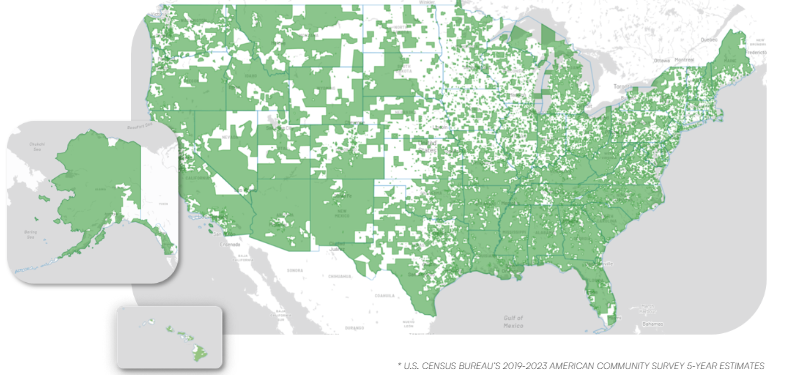Understanding the Growth Trajectory of New Credit Union Branches
Projecting deposit growth for new branches helps credit unions set realistic expectations and make informed expansion decisions.


Opening a new branch represents a significant investment for credit unions. Yet many institutions struggle to set realistic expectations for deposit growth, often relying on gut feelings rather than data-driven projections. This uncertainty can lead to poor resource allocation and disappointing returns on investment.
At CUCollaborate, we've analyzed bank new branch growth patterns from 2011 to 2024 to provide credit unions with a framework for projecting new branch deposit acquisition. Our research offers valuable insights into what credit unions can realistically expect when opening new locations.
In this article, we'll explore:
- The typical growth trajectory for new branches
- Key milestones in branch deposit acquisition
- How long it takes for branches to reach maturity
- Why understanding these patterns matters for strategic planning
The Data Behind Branch Growth Projections
Our analysis draws from the Federal Deposit Insurance Corporation (FDIC) Summary of Deposits database, which provides comprehensive information on bank branches established between 2011 and 2024. Here, we focus specifically on banks with five to nine branches and $1-2 billion in deposits—institutions comparable in size to many credit unions.
The FDIC data includes valuable metrics such as:
- Deposit amounts by branch
- Establishment dates
- Bank ownership information
- Branch growth patterns over time
To ensure comparability, we adjusted all branch deposit volumes for inflation, providing a consistent basis for comparison across the decade-long study period.
The Five-Year Growth Pattern: What to Expect
The most significant finding from our research is that new branches typically experience rapid growth for approximately five years before plateauing. This pattern holds true across different markets and institution sizes, though the specific deposit amounts vary.
For the median new branch (for the aforementioned banks), the deposit growth trajectory follows this path:
- Year 1: $30 million
- Year 2: $53 million
- Year 3: $64 million
- Year 4: $71 million
- Year 5: $81 million
- Years 6-10: Growth slows significantly, with deposits plateauing around $105 million by year 10
This "inverse hockey stick" pattern—steep growth followed by a flattening curve—appears consistently across our dataset. Understanding this typical trajectory helps credit unions avoid unrealistic expectations of continuous rapid growth beyond the five-year mark.
Beyond the Median: The Range of Possible Outcomes
While the median branch reaches $30 million in deposits by the end of its first year, actual performance varies significantly. Our analysis reveals that new branches in the 25th percentile acquire only $8.8 million in their first year, while those in the 75th percentile reach $69 million.
This variability continues throughout the branch lifecycle. By year 5, branches in the 25th percentile hold $48 million in deposits, while median branches reach $81 million, and branches in the 75th percentile accumulate $152 million
These differences highlight the importance of considering multiple scenarios when projecting new branch performance. Credit unions should develop plans that account for both conservative and optimistic outcomes.
Key Factors Influencing Branch Growth Rates
Several factors explain why some branches outperform others in deposit acquisition:
- Location characteristics: population density, income levels, competition
- Institution name recognition and brand awareness
- Marketing and outreach efforts
- Branch design and staffing models
Credit unions can influence many of these factors through strategic planning and resource allocation. For example, investing in targeted marketing during a branch's first two years—when growth potential is highest—can help accelerate deposit acquisition during this critical period.
Putting Branch Growth in Context: The Proportional View
When evaluating branch performance, it's important to consider deposits not just in absolute dollars but also as a percentage of the institution's total deposits. Our research shows that the median new branch (for the aforementioned banks) represents approximately 2.2% of total deposits in year one, increasing to 6.1% by year five.
This proportional perspective helps credit unions understand how a new branch contributes to overall growth. It also explains why the impact of adding a new branch varies significantly based on institution size—a $30 million first-year branch has a different proportional impact for a $500 million credit union than for a $2 billion institution.
Practical Applications for Credit Union Branch Planning
Understanding the typical growth trajectory of new branches helps credit unions in several ways:
- Setting realistic performance expectations
- Creating more accurate financial projections
- Developing appropriate staffing and resource plans
- Establishing meaningful benchmarks for evaluating performance
- Informing decisions about future expansions
For example, knowing that deposits typically plateau after five years might lead a credit union to adjust its long-term staffing plan or to consider a new branch every four to five years to maintain momentum in overall deposit growth.
Building Your Branch Growth Projection Framework
Based on our research, we recommend credit unions follow these steps when projecting deposit growth for new branches:
- Start with the median growth path as your baseline projection
- Consider the 25th and 75th percentile scenarios as your likely range of outcomes
Adjust these projections based on your specific circumstances:
- Local market conditions and competition
- Your institution's current market presence
- Planned marketing investments
- Branch format and service model
This approach provides a data-driven foundation for branch planning while acknowledging the unique factors that influence each credit union's results.
Conclusion: Data-Driven Branch Growth Planning
New branches follow a predictable growth pattern, with rapid expansion for approximately five years before reaching a plateau. By understanding this trajectory and the factors that influence it, credit unions can make more informed decisions about branch investments and set realistic expectations for performance.
The five-year mark represents a critical milestone in branch development. During this initial period, credit unions should focus on aggressive member acquisition and deposit growth. After year five, strategies may need to shift toward maximizing efficiency and profitability as deposit growth naturally slows.
At CUCollaborate, we help credit unions apply these insights to their specific situations, creating customized branch growth projections that account for local market conditions and institutional strengths. By grounding expansion plans in data rather than anecdotes, credit unions can make more considered decisions about when, where, and how to grow their branch networks.
Branch Strategy & Analysis



















